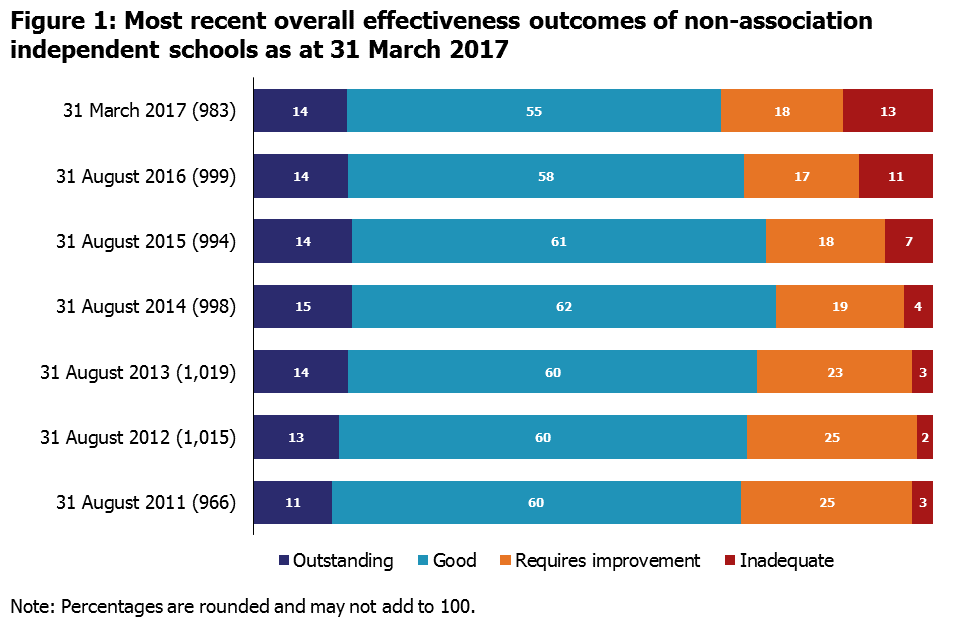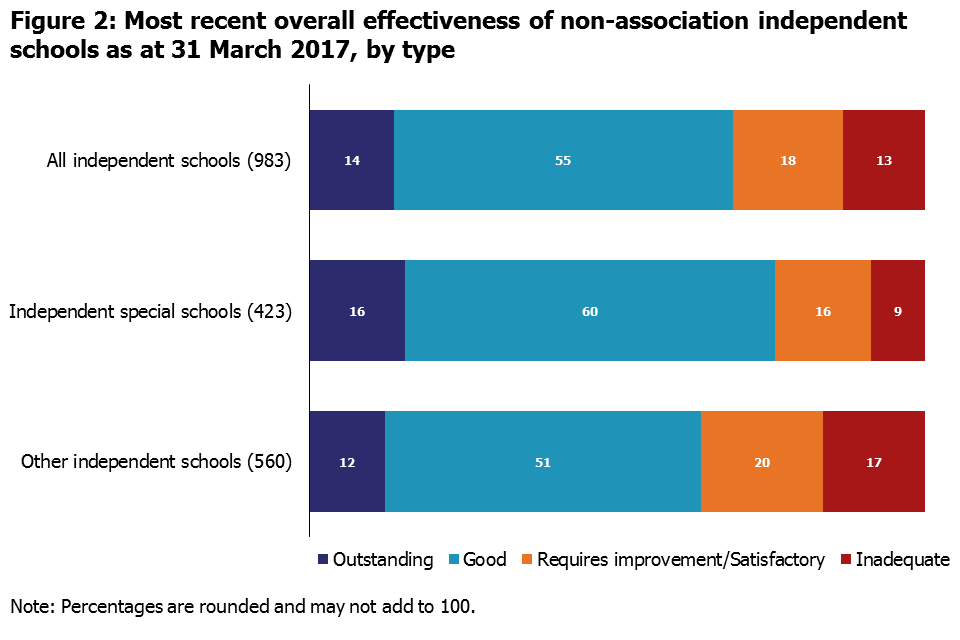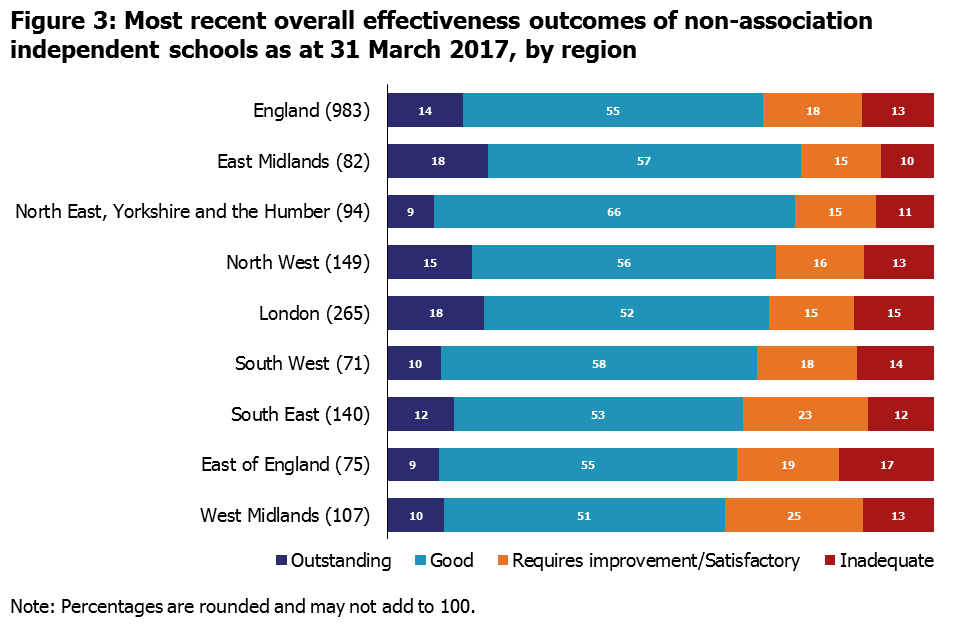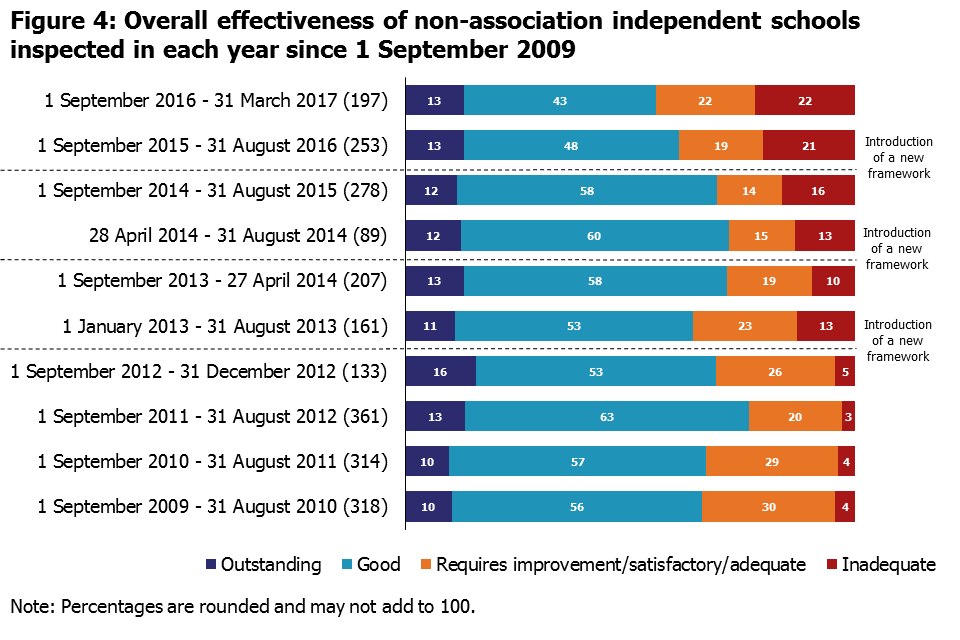Non-association independent schools inspections and outcomes official statistics as at 31 March 2017
Updated 18 December 2019
This release contains:
-
provisional data for inspections completed between 1 September 2016 and 31 March 2017
-
most recent inspection outcomes as at 31 March 2017
-
revised data for inspections completed between 1 September 2015 and 31 August 2016
Non-association independent school inspection outcomes have declined
At the end of March 2017, 69% of schools inspected by Ofsted were judged good or outstanding at their most recent inspection. This is 3 percentage points lower than the proportion judged good or outstanding as at 31 August 2016.

The number of schools judged inadequate has continued to increase
At the end of March 2017, 130 schools (13%) were judged inadequate at their most recent inspection. This is 2 percentage points higher than the number reported in August 2016, and 9 percentage points higher than in August 2014.
Inadequate schools have weaknesses across a number of standards
Inadequate schools inspected this year mainly failed to meet standards associated with leadership and management, the welfare health and safety of pupils and the quality of education.
1. Schools at their most recent inspection
At 31 March 2017 there were 1,067 open non-association independent schools, 983 of which had received a standard inspection by Ofsted[footnote 1]. Of these, 69% were judged good or outstanding, 18% required improvement and 13% were inadequate at their most recent inspection. The proportion judged good or outstanding is 3 percentage points lower than the position at 31 August 2016.

At the end of March 2017, 130 schools (13%) were judged inadequate at their most recent inspection. This continues the decline since August 2014, when only 43 schools (4%) were inadequate. This reflects the higher expectations of the new independent school standards, introduced by the Department for Education in September 2014 and supplemented in January 2015.
Independent special schools are performing better than other independent schools (for instance private schools catering for primary or secondary aged pupils, or catering for both age groups). Seventy six per cent of special schools were judged good or outstanding compared with 64% of other schools. Other independent schools also have a higher proportion of schools found inadequate (17%) compared with special schools (9%).
2. Regional inspection outcomes
The number of non-association independent schools varies considerably between regions. London has the highest number of schools (281), and the South West has the lowest (77 schools). A large proportion of schools are in London and the South East (41%).
Figure 3 shows that, of those inspected, the East Midlands has the highest proportion of schools judged good or outstanding (76%). It was the only region to see an improvement in the grade profile since August 2016. The East Midlands and London have the highest proportion of schools judged outstanding (18%).
Nationally the proportion of schools judged good or outstanding at their most recent inspection was 3 percentage points lower in March 2017 than it was at 31 August 2016. The East of England saw the largest regional fall (11 percentage points), and 17% of its schools are now inadequate. The West Midlands has the lowest proportion of schools judged good or outstanding overall (62%).

3. Inspections between 1 September 2016 and 31 March 2017
Since September 2015, independent schools have been inspected under the common inspection framework, which holds them to account in similar ways to maintained schools and academies for the quality of their work.
Between 1 September 2016 and 31 March 2017, Ofsted carried out 198 standard inspections[footnote 2]. Over a fifth of these (44 schools) were judged to be inadequate (see figure 4), with 35 also being found ineffective for safeguarding.
The proportion of schools judged to be requires improvement and inadequate each year has been increasing steadily since 2014.
In the year to date, outcomes for other independent schools show over half (59 of the 110 schools inspected) were less than good, far worse than independent special schools, where just under a third (28 of the 88 inspections) were less than good.

Of the 198 schools inspected this year to date, 170 had been inspected previously. Of these, 73 (43%) declined from their previous inspection, 72 (42%) remained the same grade, and only 25 (15%) improved on their judgement.
This academic year to date there were also 76 progress monitoring inspections conducted of schools previously judged not to have met all of the independent school standards. Of these, only 46 have now improved to meet the standards checked on these inspections.
4. Compliance with independent school standards
Ofsted checks and reports on the extent to which schools meet the independent school standards. The percentage of standard inspections where the school was meeting all requirements has decreased to 63% in 2016/17 to date, from 74% in 2014/15.
Figure 5: Compliance to standards of non-association independent schools inspected and judged inadequate between 1 September 2016 and 31 March 2017
| Met (No.) | Not met (No.) | |
|---|---|---|
| All Standards | 0 | 44 |
| Part 1: Quality of Education | 10 | 34 |
| Part 2: Spiritual, moral, social and cultural education of pupils | 30 | 14 |
| Part 3: Welfare, health and safety of pupils | 7 | 37 |
| Part 4: Suitability of the proprietor, staff and supply staff | 22 | 22 |
| Part 5: Premises and accommodation of schools | 24 | 20 |
| Part 6: Provision of information for parents, carers and others | 22 | 22 |
| Part 7: Manner in which complaints are to be handled | 35 | 9 |
| Part 8: Quality of Leadership and Management | 1 | 43 |
Of the 44 schools judged inadequate this year, many failed to meet standards associated with leadership and management (43), the welfare health and safety of pupils (37) and the quality of education (34).
5. Revisions to previous release
Provisional data indicated that there were 248 inspections between 1 September 2015 and 31 August 2016 (published by 30 September 2016). Revised data shows that there were an additional 5 inspections which were subsequently published. Two schools were judged good, 2 requires improvement and one inadequate.
The addition of these inspections has marginally changed the profile of overall effectiveness grades. The proportion of schools judged to require improvement has increased from 18% to 19% (due to rounding). Further details can be found in the revised tables in the charts and tables file.
6. Consultation on changes to the frequency of publication of statistics on non-association independent schools
Please note that Ofsted are currently consulting on a change to the frequency of publishing statistics on inspections and outcomes for non-association independent schools. Our proposals also include publishing management information on a regular basis. The consultation closes on 14 September 2017 and users are encouraged to read and respond to the consultation.
7. Notes
Data in this release is from inspections undertaken between 1 September 2016 and 31 March 2017 and most recent inspections of open schools at 31 March 2017, where the inspection report was published by 30 April 2017. If an inspection report is not published by 30 April 2017 then the previous inspection, where available, will be reported as the school’s most recent inspection.
From September 2015, data in this official statistics release reflects judgements made on inspections conducted under sections 99, and 109 (1) and (2) of the Education and Skills Act 2008. The regulations set out the standards on which inspectors report. This includes the extent to which the school meets the requirements of the Education (Independent School Standards) Regulations 2014 (referred to as the independent school standards). An explanation of the main uses of this data and further contextual information and the arrangements for quality assurance is provided in the accompanying methodology and quality report.
All official statistics for non-association schools can be found at the following webpage: https://www.gov.uk/government/collections/independent-schools-inspections-and-outcomes under the heading ‘documents’. The methodology and quality report for these official statistics can be found alongside this release. This report also provides information about strengths and limitations of the statistics.
In 2016, the National Statistician published new guidance covering management information and official statistics.
8. Glossary
Independent school standards regulations
Section 94 of the Education and Skills Act 2008 specifies that the Secretary of State must set out in regulations the standards that independent schools must meet. The standards must be about: quality of education; spiritual, moral, social and cultural development of pupils; welfare, health and safety of pupils; suitability of staff and proprietors; premises and accommodation at the school; provision of information; the manner in which complaints are to be handled; and the quality of leadership and management.
The standards are set out in The Education (Independent School Standards) Regulations 2014, which specify the provision a school must make.[footnote 3] Schools must meet these standards in order to register, and to continue to be registered, as independent schools.
Independent schools
Independent schools are defined by section 463 of the Education Act 1996, as amended. They provide full-time education for:
- 5 or more pupils of compulsory school age, or
- at least one pupil of that age for whom a statement is maintained under section 324, or who is looked after by a local authority (within the meaning of section 22 of the Children Act 1989)
It is immaterial if full-time education is also provided at the school for pupils under or over compulsory school age.[footnote 4]
The DfE’s policy position with respect to full time education is contained within Part A of the departmental advice ‘Registration of independent schools’.
Ofsted only inspects the quality of educational provision and compliance with independent school standards in independent schools which are not members of independent schools associations (referred to as non-association schools). Schools which are members of independent schools associations are inspected by inspectorates approved by the Secretary of State for this purpose: the Independent Schools Inspectorate and the School Inspection Service. All inspections are carried out at the request of the Secretary of State, which is the registration authority for all independent schools.
Inspection types
Ofsted conducts the following inspection types.
Pre-registration inspections
The Secretary of State is the registration authority for independent schools in England, and maintains a register of independent schools. When a proprietor has made an application for registration of an independent school the Secretary of State must notify HMCI, who must then inspect the school. The purpose of the inspection is to report to the registration authority on the extent to which the independent school standards are likely to be met if the school were to be registered. Such inspections are conducted under section 99 of the Education and Skills Act 2008.
When a proprietor makes an application for a new boarding or residential special school, an integrated pre-registration inspection is made by both an education and a social care inspector.
Standard inspections
Standard inspections of independent schools are conducted under sections 109 (1) and (2) of the Education and Skills Act 2008. Ofsted will report to the DfE on the extent to which the school complies with the independent school standards, and will also make evaluative judgements about the quality of education provided by the school under Ofsted’s common inspection framework. Ofsted will normally contact the school by telephone to announce the inspection around lunchtime on the day before the inspection is due to start.
Progress monitoring inspections
Ofsted conducts progress monitoring inspections at the request of the Secretary of State to check the progress made by independent schools to address weaknesses identified at their last inspection. These inspections are conducted under sections 109 (1) and (2) of the Education and Skills Act 2008.
Schools identified as having weaknesses are normally required to submit an action plan to the Secretary of State setting out the steps they will take to address their weaknesses and meet the relevant independent school standards and/or national minimum standards. Action plans must specify the timescale within which the steps will be taken.
In progress monitoring inspections, inspectors assess and report on the amount of progress schools have made with implementing their action plan. They will check whether the previously unmet independent school standards or national minimum standards are now met.
Emergency inspections
Emergency inspections of independent schools are conducted under sections 109(1) and (2) of the Education and Skills Act 2008. They are carried out at the request of the Secretary of State for a variety of reasons, for example as a result of a complaint or concern made known to the DfE. The issue that triggered the inspection will be used as the main line of enquiry for the inspection[footnote 5], and Ofsted will report to the DfE whether the school meets the independent school standards relevant to the issue. Emergency inspections are conducted without notice and reports of these inspections are only published at the request of the Secretary of State.
Material change inspections
Outside normal inspection cycles, Ofsted carries out material change inspections of registered independent schools at the request of the Secretary of State, when the school wishes to make a material change to their premises, intake or age range; the provision they make for disabled pupils and those with special educational needs; or there is a change to the proprietor. These inspections are conducted under section 162 of the Education Act 2002.
Inspectors will consider the implications of the material change and report to the Secretary of State whether the school is likely to meet the relevant independent school standards, if the material change is implemented. The school cannot implement the proposed change unless the Secretary of State grants permission.
9. Further information
Contact for comments or feedback
If you have any comments or feedback on this publication, please contact Louise Butler on 03000 131 457 or Louise.Butler@ofsted.gov.uk
Acknowledgements
Thanks to the following for their contribution to this statistical release: James Jordan, Austen Norris, Thomas Newcombe, Chris Foley and Michael Taylor.
-
Not all open schools have received a standard inspection. Once registered, new schools receive their first standard inspection in their first year of operation, at the request of the Department for Education (DfE). ↩
-
In 2016/17 there was one school where no inspection judgements were made, but compliance with the independent school standards was checked. ↩
-
The Education (Independent School Standards) Regulations 2014 came into effect on 5 January 2015. ↩
-
This definition of ‘independent school’ forms part of the definition of ‘an independent educational institution’ for the purpose of the 2008 Act. ↩
-
Ofsted does not investigate individual complaints. Rather, the focus of inspection are any issues that impact the whole school as a whole, that the complaint may give rise to. ↩

